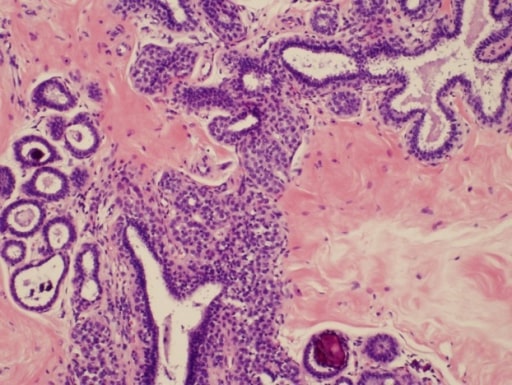Playlist
Show Playlist
Hide Playlist
Benign Tumors of the Breast
-
Slides Breast Female Repro.pdf
-
Download Lecture Overview
00:01 Our first benign tumor here will be fibroadenoma. 00:05 Characteristics: Small, mobile, firm mass with sharp edges. 00:10 This is well encapsulated. 00:13 Small, maybe freely mobile. 00:16 Who is your patient? Young female. 00:18 Just like fibrocystic change. 00:21 Both of these patients are young. 00:25 Increase in size and tenderness with increased estrogen. 00:28 Here once again, we’re looking at hormonal type of changes. 00:33 Fibrocystic change, we did the same. 00:35 Not a precursor for breast cancer. 00:37 True benign tumor. 00:40 Then we have a papilloma, intraductal papilloma. 00:44 What’s occurring here? A small tumor that grows in the lactiferous duct. 00:48 So if you’re clearly not at all good with your -- as I said, your breast apparatus, I’ll bring this to your attention. 00:55 But if you want to get ahead a little bit, at least take a look at what’s your breast -- and what it looks like as we go from the nipple back to the stroma. 01:02 Your lactiferous duct would be – well, as the name implies, lactiferous means milk. 01:08 So you have your lactiferous sinuses that are responsible for ejecting the milk so that the nipple, when the newborn is ready to suckle, the milk then comes out with the help of oxytoxin and company, correct? What happens here is that the lactiferous duct may then undergo, well, in other words, a tumor. 01:28 And so therefore when that happens, you can imagine that this -- you call this a papilloma. 01:33 So you can actually call this a tumor. 01:36 Now the notes are the following, it’s important here. 01:38 Here, this is a benign tumor. 01:40 However, the nipple discharge here will be bloody. 01:43 So if therefore, if your female patient tells you that her shirt, her undershirt or whatnot or even her bras and such, when she takes of her bras, that she finds blood in her breasts. 01:56 At first, you are a little – oh actually not just a little -- you’re very much concerned and you want to rule out breast cancer, correct? However, at the same time, if you do a mammography and then perhaps you’ll find that it’s intraductal papilloma. 02:11 Serous and bloody nipple discharge, slight increase in the risk for breast cancer. 02:17 But for the most part, benign. 02:19 Intraductal papilloma. 02:21 We have phyllodes tumor. 02:23 A phyllodes tumor. 02:24 Well, here, what I’d like you to do is compare and contrast your fibroadenoma to phyllodes. 02:32 It’s pretty much a derivative of it. 02:34 I’m not going to spend a lot of time with this. 02:36 Understand that the description here in the clinical characteristics will be quite different. 02:42 If it’s small and fibroadenoma, it will be large and bulky. 02:46 In fact, we call this “leaf-like projections” and you might have cysts. 02:54 Characterstics become of utmost importance for you with phyllodes. 02:58 I would know fibroadenoma in greater detail. 03:01 Most common with phyllodes will be in the? Look at your age group here. 03:05 If it’s a patient who’s a young female, with fibroadenoma. 03:09 Your patient with phyllodes will be an elderly patient, sixth decade. 03:13 And with phyllode tumor, because of a larger size, there might be a greater chance of going onto breast cancer. 03:20 So as you go through phyllode, you’re comparing and contrasting this with fibroadenoma. 03:24 When you go into fibroadenoma, you’re comparing and contrasting this with fibrocystic change. 03:29 And if you’re thinking about bloody nipple, maybe perhaps and hopefully it’s just a benign tumor known as an intraductal papilloma by the lactiferous sinus.
About the Lecture
The lecture Benign Tumors of the Breast by Carlo Raj, MD is from the course Reproductive Pathology: Breast Disease with Carlo Raj.
Included Quiz Questions
Which of the following breast conditions occurs more often in the age group over 50 years?
- Phyllodes tumor
- Intraductal papilloma
- Acute mastitis
- Fibrocystic changes
- Fibroadenoma
Which of the following is TRUE for both fibroadenoma and fibrocystic changes?
- Size fluctuates in response to estrogen.
- They usually present as a solitary well-encapsulated mass.
- They are difficult to palpate on gross examination.
- Both increase the risk for breast carcinoma.
- They may be hemorrhagic on removal.
Which of the following statements about intraductal papilloma is INCORRECT?
- It is the most common tumor in women younger than 35 years old.
- It is a small tumor of the lactiferous ducts.
- It may present with bloody or serous nipple discharge.
- It is associated with a slight increase in the risk of breast cancer.
- It is typically located beneath the areola.
Customer reviews
5,0 of 5 stars
| 5 Stars |
|
5 |
| 4 Stars |
|
0 |
| 3 Stars |
|
0 |
| 2 Stars |
|
0 |
| 1 Star |
|
0 |





